How To Pick A Good Watermelon
Here are six tips for How to Pick a Good Watermelon that’s ripe and sweet, gathered from lots of conversations with produce people, farmers, and personal experience. If you know how to check for things like the field spot, it makes the selection process much easier!
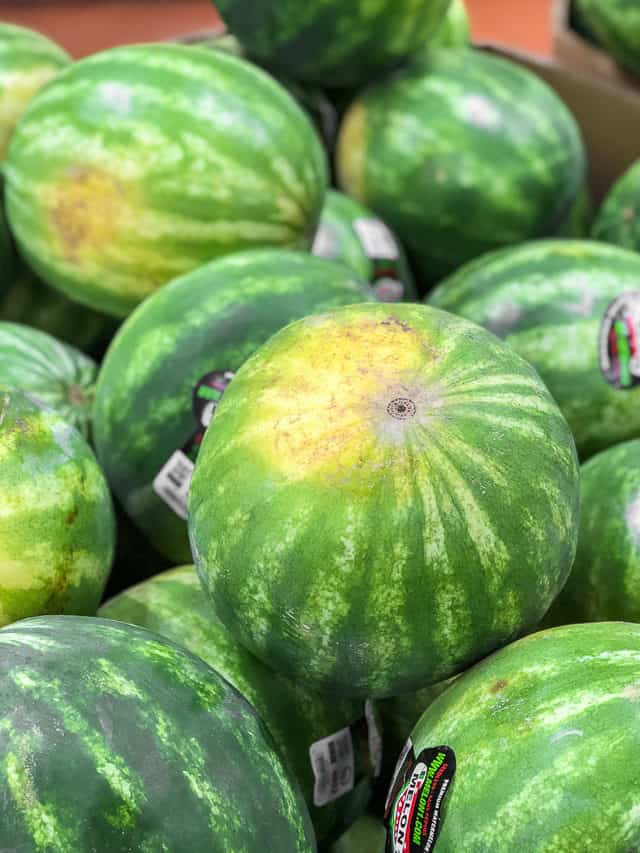
Picking out a perfect watermelon at the grocery store was always a semi-anxiety plagued experience for me when I didn’t know what I was looking for.
If you pick a bad one, you’re stuck with 15-20 whopping pounds of watermelon terribleness. And then your options are to either force yourself to eat this yucky watermelon or throw it away…and both are less than desirable options.
There have been a few times where I ended up throwing it out because it tasted like a crunchy watermelon rind cucumber, and no one in my family would eat it.
My goal today is to help you pick a sweet, ripe watermelon because I know how disappointing it is to get home, take your first bite of some sort of produce you buy, only to find out it isn’t good.
All the tips here are tidbits I have gathered from personal experience and lots of conversations with produce people and farmers. Here’s how to pick the best watermelon!
Tip #1: Find the Field Spot
If you don’t even read the other tips, I find this is the biggest indicator of a good watermelon.
The field spot, or ground spot, is a creamy spot on the outside, and it’s where the watermelon was resting on the ground, or the underside of the watermelon.
The field spot should be a yellowish creamy color, like shown with my watermelon:
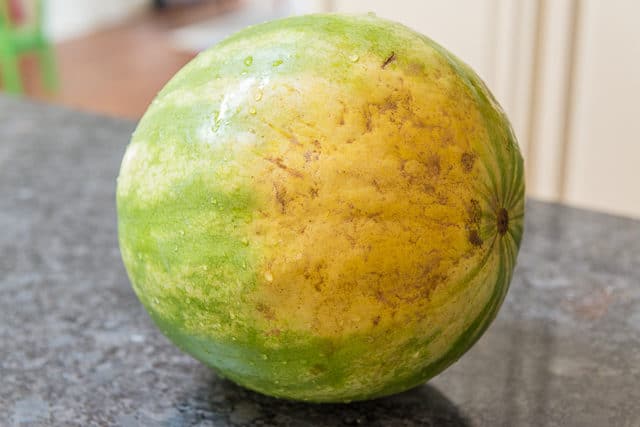
The more dark yellow the field spot is, the longer it was on the vine sweetening up. If the field spot is a white spot (or not even there), this indicates an underripe melon.
What’s interesting is you’ll notice that the other side of the same watermelon looks completely different:
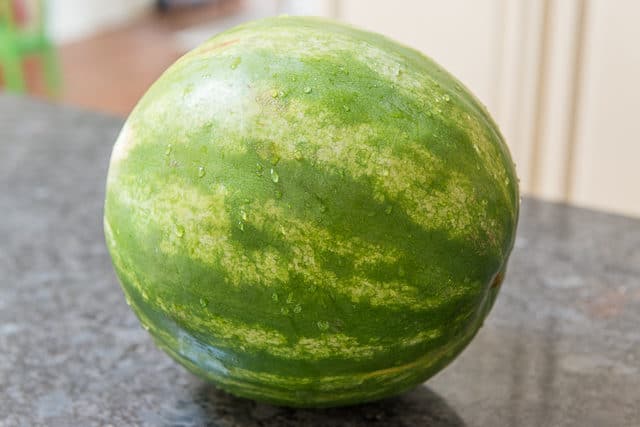
It’s much prettier and more typical of what I picture when I think of a watermelon, and that’s okay.
I find that the best watermelons I buy can sometimes look really gnarly on one side, usually the underside of the melon where it was resting on the ground, and then unblemished on the other. But you don’t want it to look perfectly green all the way around.
Note: It’s fine if there are green stripes, or not, or if there’s solid green color on most of the outside of the watermelon. The exterior pattern is more about the varieties of watermelons that your grocery store carries, and not anything to do with being a ripe melon or not.
Tip #2: Pick a Dull Looking Exterior
A shiny exterior appearance indicates an underripe watermelon, though this can be a bit tricky if they’ve added wax, and then you can’t really tell. This applies to honeydew melons too. Don’t be put off by a dull looking watermelon.
Tip #3: Knock on It with Your Knuckles
Your knuckles should bounce off the melon, and the surface should be pretty hard and firm. You will get a dull thud if the flesh is soft, which indicates it’s starting to spoil. Avoid any melon with soft spots!
Rather than a dull thud, you are looking for a hollow sound, a deep sound. It takes a lot of testing to learn what this sounds like, so don’t use it as your only indicator.
If you don’t want to knock with your knuckles, then you can push firmly with the tip of your thumb. Ideally there should be little or no give when you push in.
Tip #4: Get the Heaviest One for Its Size
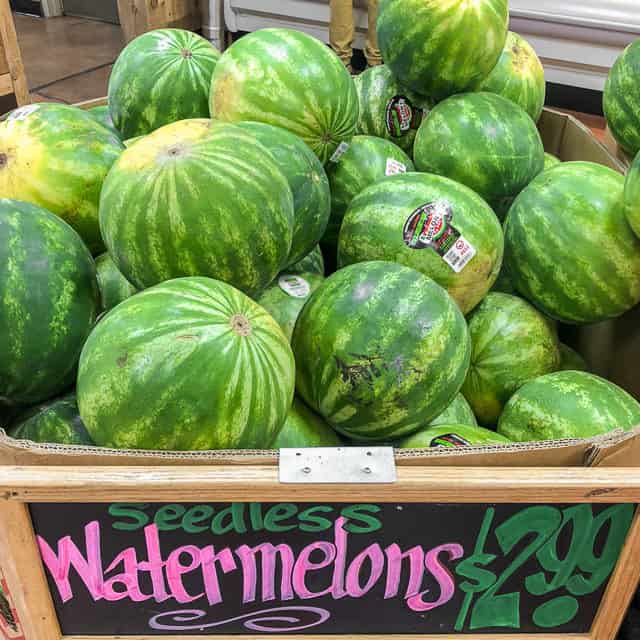
This applies to pretty much all produce, but you want to pick a heavy watermelon, meaning the one that is the heaviest for its size. That means there’s more water in it, which means a juicy watermelon.
The easy way to check for this is to pick up a few melons and compare their weights (or, if there’s a scale nearby, actually weigh them).
The whole watermelon pictured above here in my post was a whopping 18 pounds! It was heavier than the other comparably sized melons around it. It’s more bang for your buck too.
Tip #5: Check for a Uniform Shape
Some watermelons are round, some are oval, and either is fine. They are just different varieties. But if there are irregular bumps, this indicates the melon may have gotten inconsistent amounts of sun or water, and you should avoid that one.
Tip #6: Look for the Sugar Spots and Pollination Points
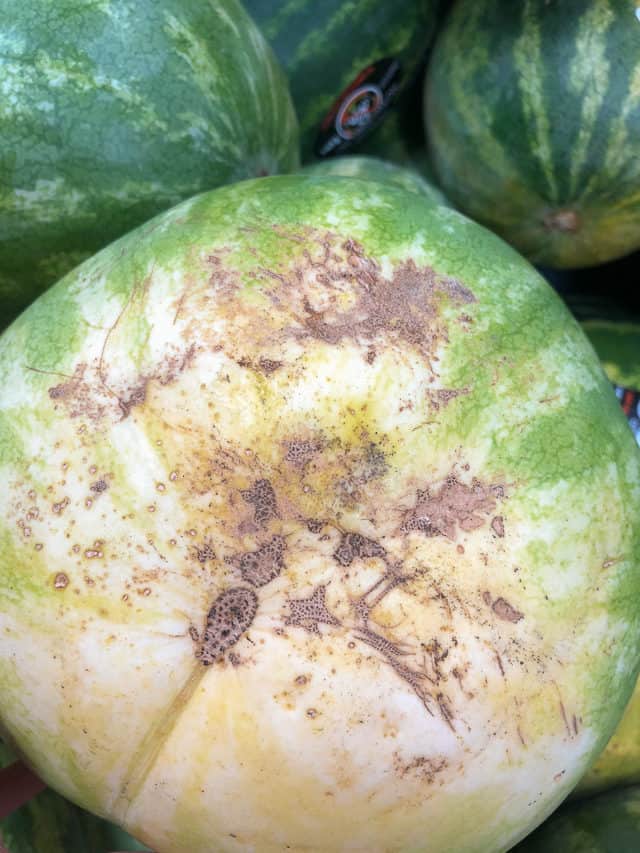
This tip was emailed to me many months ago by Tom, a produce manager for a major grocery chain. If you see black spots on the melon (as pictured above), this is where sugar is seeping out and indicates a sweet melon. At first glance, a sugar spot might just look like dirt, but if it doesn’t rub off easily, then it’s a sugar spot.
Also, if you see dots in a line (not a scratch), these are pollination points, and the more of them the better. I’ve been looking for these every time I pick up a melon and have had great luck with it in addition to the other tips. Thank you, Tom!
Though the above melon did not have a creamy yellow spot (it’s a little white), the sugar spots are a good sign. It was indeed a sweet watermelon.
What about the stem?
I’ve never seen a watermelon with its green stem on, though perhaps you’re more likely to find one at a farmers market. Odds are it won’t come up anyway, but I don’t know if any ripeness indications from the stem.
Once you’ve picked out a good watermelon, take a look at my quick guide for How to Cut a Watermelon, which is how I always cut watermelon to keep in the fridge. But is especially the best way to serve this delicious fruit for parties and entertaining.
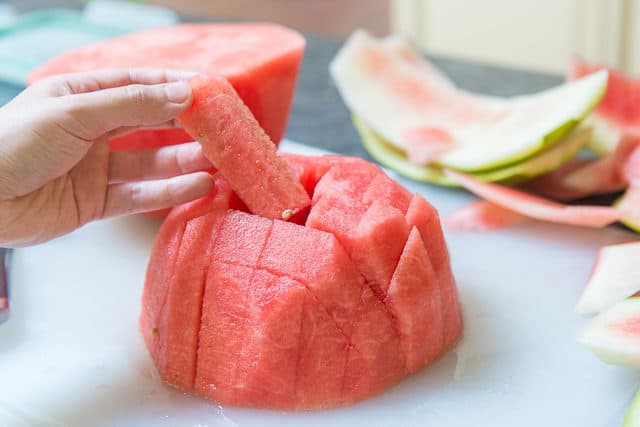
The middle of the watermelon always has the best flavor, so you’ll want to cut away a substantial amount of rind.
This method of cutting is SO much easier than cutting the typical triangles that include the rind, and you can either cut it into sticks or cubes. My perfect slice is actually the stick!
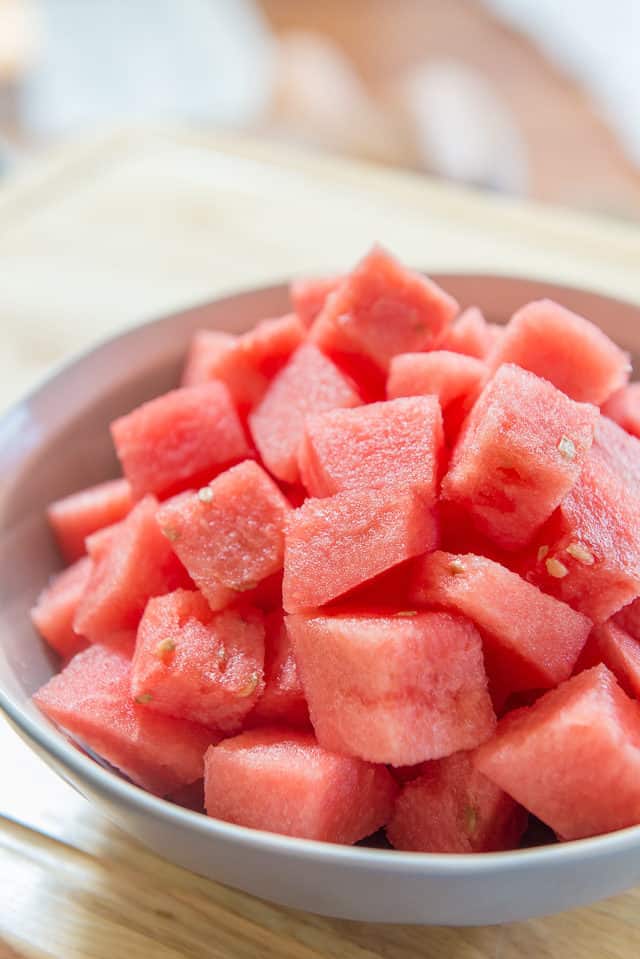
Just make sure to use a sharp knife so you get crisp pieces.
Click the photo above for my guide on cutting. Enjoy watermelon season!
More Tips and FAQ
If it’s cut, the watermelon must be stored in the fridge and can be kept in a large container for up to 5 days. An uncut watermelon can be kept at room temperature for a few days, but I find it’s best to get it into the fridge as quickly as possible, especially since watermelons do not ripen further on the counter.
Yes, but it’s not something you’ll want to eat again in a thawed state. I freeze watermelon to blend into a Watermelon Slushie or as ice cubes for Summer Drinks.
In the South they serve pickled watermelon rinds as a kind of relish, and it’s very good! I’ve never made it myself though. Only had it in restaurants.
Did you enjoy the recipe? Please leave a 5-star rating in the recipe card below and/or a review in the comments section further down the page. Or, follow me on Facebook, Instagram or Pinterest!
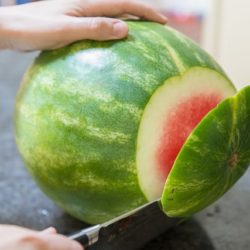
How to Pick a Good Watermelon
Ingredients
- 1 large watermelon
Instructions
- Find the Field Spot – Look for a deep yellow color. If there’s a white field spot, or no field spot at all, it likely won’t be good.
- Pick a Dull Looking Watermelon – A shiny appearance indicates an underripe melon.
- Knock on It with Your Knuckles – Your knuckles should bounce off the melon, and the surface should be pretty hard/firm. Soft flesh indicates it’s starting to spoil.
- Get the Heaviest One for Its Size – This applies to pretty much all produce, but you want to pick the watermelon that is the heaviest one for its size. That means there’s more water in it.
- Check for a Uniform Shape – Some watermelons are round, some are oval, and either is fine. But if there are irregular bumps, this indicates the melon may have gotten inconsistent amounts of sun or water.
- Look for the Sugar Spots and Pollination Points – If you see black spots on the melon, this is where sugar is seeping out and indicates a sweet melon. Also, if you see dots in a line (not a scratch), these are pollination points, and the more of them the better.
- If you want an easy way to cut the watermelon into sticks or cubes, see my How to Cut a Watermelon post. Enjoy!
Nutrition
Nutrition is estimated using a food database and is only intended to be used as a guideline for informational purposes.
Post updated with new photos and more tips in June 2018. Originally published April 2011.

288 Comments on “How To Pick A Good Watermelon”
Great tips for picking watermelon and cantaloupe.
Does anyone know how to pick honeydew melon?
HONEYDEW MELONS
http://www.thehealthycouple.com
To answer your question about honeydew melons, this is an excerpt from my not-yet-published book:
Surefire buying method: Find a honeydew that has 1) sweet smell, 2) some yellowish tint with the green, and here’s the best test, 3) has a mildly sticky feel. When honeydews are really ripe, the normally smooth, slick-feeling skin will get sticky. Unless the honeydew is really starting to feel mushy on the outside, it will be great. I usually scan the entire selection for the yellowish coloring and then pick out those to feel for the stickiness and then smell for a sweet smell.
Storage: Honeydews will continue to ripen after picked, as is true of all melons. DO NOT PUT IT IN THE FRIDGE UNTIL IT STARTS TO HAVE AN AROMA OR FEEL STICKY. Honeydews, like underripe watermelons, can stay at room temperature for a week or two, depending on its ripeness. If you put it in the fridge too early, it may not ripen well even when you take it out of the fridge and leave it on the counter for a few days.
NOTE: You can buy a honeydew that has no smell or sticky feel. Usually they will ripen in a week or so. However, some honeydews are picked so green that they will never ripen.
Bill, this is absolutely wonderful. When is your book going to be published?
A number of people want to know that. My main work now is working with couples who are in distress. The book hasn’t been my top priority. However, I’m working on a series of books on healthy relationships. I may get the fruit buying book out as I’m publishing the others. As you can tell, I’ve put a lot of thought into this. I have a couple of titles for the book:
BLUEDICKS, SPERM WHALES, AND BLOOD ORANGES
A Humorous (Okay, Hilarious) and Professional (Okay, Helpful) Look At How to Buy Fruit That Actually Tastes Great
PICKING GOOD FRUIT IS LIKE GOING ON A BLIND DATE:
You really never know what you got until it’s too late
I thought your readers would appreciate knowing how to buy honeydew (and as I’ve written before on this blog cantelope and watermelon.) I think people get tired of buying something that tastes more like a cucumber!
LOL! I like the picking good fruit blind date one. Well, such is life, I suppose. Always so much to do and limited time available. Let us know about the progress =)
Thanks for the vote on the title, Joanne. The reasoning behind the first title is related to the humor I bring out about how things are named…including fruit. I think you would find that enjoyable and fascinating.
I will keep you posted on my progress.
Thanks for the info on how to pick out a honeydew melon. Now I should be able to pick out watermelon, cantaloupe and honeydew melon. All the tips have been great.
Hi there,
I grew up on a watermelon farm and one top you might want to add is to look at the stem. This is a dead giveaway to how long the watermelon has been off the vine. If it’s brown, your watermelon is going to be over ripe. However, the best tip would be to go to a farmer’s market…way better watermelons than the grocery store :).
Hey I just wanted to say I eat my weight in Watermelon (Don’t ask) so have gotten pretty good about picking–you’re right on. What I needed was your cutting method; Thanks. Happened across your site via DIL and immediately bookmarked. It rocks!
Hi Rita! Fantastic, glad the cutting technique helps you out! What is DIL? LOL I’m drawing a blank for that one!
Daughter in Law 🙂
I was told at the farmers market this morning to always look for “Bee Tracks.” If you look at the picture above where it has the yellow field spot, you will see the brown scuff tracks. Those are made by bees. The bees are attracted to the sweetest melons.
Great information. I like your writing style too. Easy to understand.
Thanks for the tips!
Thank you, I’m so glad to hear it!
A produce manager told me years ago, when I was catering a dinner for 80 and needed guaranteed ripe watermelon, that the “striping” on the melon should be broken up and no longer defined – indicating that they’re ripe. He was right, in 20 years I’ve never picked out a bad watermelon!!
Christi, what a neat tip to share with us. I will start looking for that! Thank you!
Another good indicator is bee stings!
Did you also know that you can eat the rids? You can pickle them and they taste great. Just in case you didn’t want to compost all that rind of an 18 lb melon. Less waste, more food! 🙂
Yes, I love pickled watermelon rinds! I mention them in my video. Thanks for the tip =)
Thanks for the tips! As far as the bowl in the fridge. I hate when my watermelon chunks sit in the juices and get soggy so I took 2 large Rubbermaid bowls of the same size and drilled holes in the bottom of one of them. Then you set or “stack” that one in the other one. It leaves about an inch between them where the juices drain into leaving your chunks nice and crisp. It also gives you seed-free and pulp-free juice to use for other recipes!
Brilliant Robyn, thanks for sharing your tips!
I have used the colander method for years. No more mushy pieces in the bottom of the bowl.
never thought of that… thanks for sharing i am going to try this!
Great information! Love watermelons!
thank you for the wonderful explaination sharing with my children 🙂
Thanks Liz!
very good and skilled show
Slightly OT: Add Apples to the list of food to listen to. A light finger flick or tap will help determine where it is along the continuum between crisp and mushy.
Awesome, thanks for sharing!
Yes. It’s a good test.
Wanted to let you know I shared this ( and linked back) to this post! It is awesome! Perfect for summer!
http://allthingsfee.blogspot.com/2012/06/lifesavers-series-cleaning-fruit.html
Thanks Felicia! I’ll go check out =)
On the cantaloupe question,, SMELL IT! it should smell like a cantaloupe. It should be heavy and have rind should slightly give near the belly button. Too soft and it is over ripe. [you can freeze and use in smoothies.] Under ripe and it is just hard and never develops that sweet-sunny flavor. Best way, grow your own. On the watermelon, the stem [should have part of one if you can find it] and be dried up. Means it ripened out in the field. Heavy – yes. Honey Dew- the same. Also the firmness at the belly button will let you know if it is too old. Soft is never good on a melon of this type. Growing moons and stars watermelon, hoping to get a few.
While shopping at the local farmer’s market, I had a grower tell me to look for the “sugar beads”. These are little black sticky dots (melon sugar) that develop on the ends or scars on the watermelon. This will guarantee a sweet melon everytime…since then I stopped thumping the melons and haven’t been disappointed either!
Barb, thanks for sharing this, I’ve never heard of this technique. It’s amazing all the reader contributed tips that have been shared here in the comments. I will keep my eyes out for those!